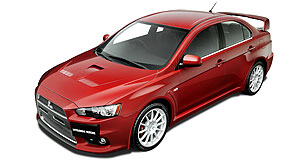Dual clutch for Evo
BY JAMES STANFORD | 23rd Jul 2007

Due to arrive in Australia early next year, the rally-bred super-sedan will be available with a six-speed automated manual transmission, much like the DSG transmission that has been such a success in Volkswagen models and which will soon debut in BMW’s new M3.
Until now, Lancer Evo models sold in Australia have only been available with a manual transmission. In Japan, Mitsubishi has offered automatic transmissions for Evo models since 2001, when it introduced the GT-A model which ran a detuned engine. Its five-speed gearbox was a regular automatic with a simple manual shift mode which meant the gearshifts were slow.
Dubbed SST, the new double-clutch gearbox can operate in automatic mode or be operated manually. The dual-clutch system is much more economical than a torque converter, reducing efficiency losses. With odd and even gears located on separate input shafts, each with their own individual clutch, the SST transmission is able to change gears as quickly as, if not quicker than, a manual gearbox.
Mitsubishi said the SST transmission will feature three different modes – Normal, Sport and S-Sport. Sport means the transmission will hold each gear for longer and the pace of gear hanges is quickened, while S-Sport allows even faster changes and holds each gear for the longest time to ensure maximum performance. Mitsubishi has also outlined an improved AWD system for its next-generation Evo hero car. The system is very similar to the existing system in that it uses an active centre differential and active yaw control sensor to ensure each wheel is given the exact amount of torque it needs for the best possible traction. The biggest change is the addition of what Mitsubishi calls ASC1 or active stability control. The ASC1 system aims to keep the vehicle under control by regulating both engine power and the braking force applied to each wheel. This system uses a brake pressure sensor located on each wheel to allow more precise control of braking force.
Read more:
Cashed-up Mitsu reveals more Lancer detailsFirst look: Mitsubishi concept points to Evo X